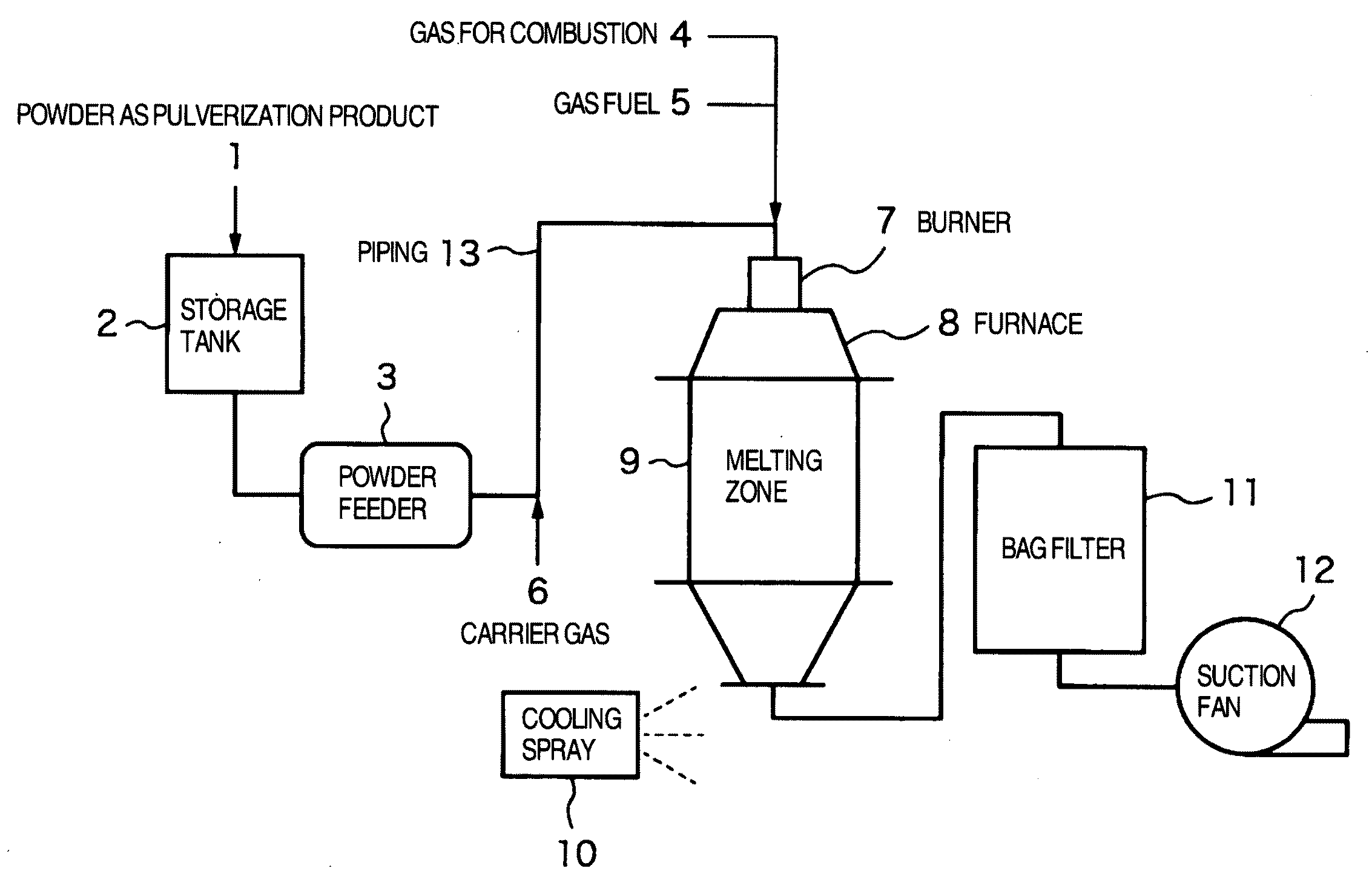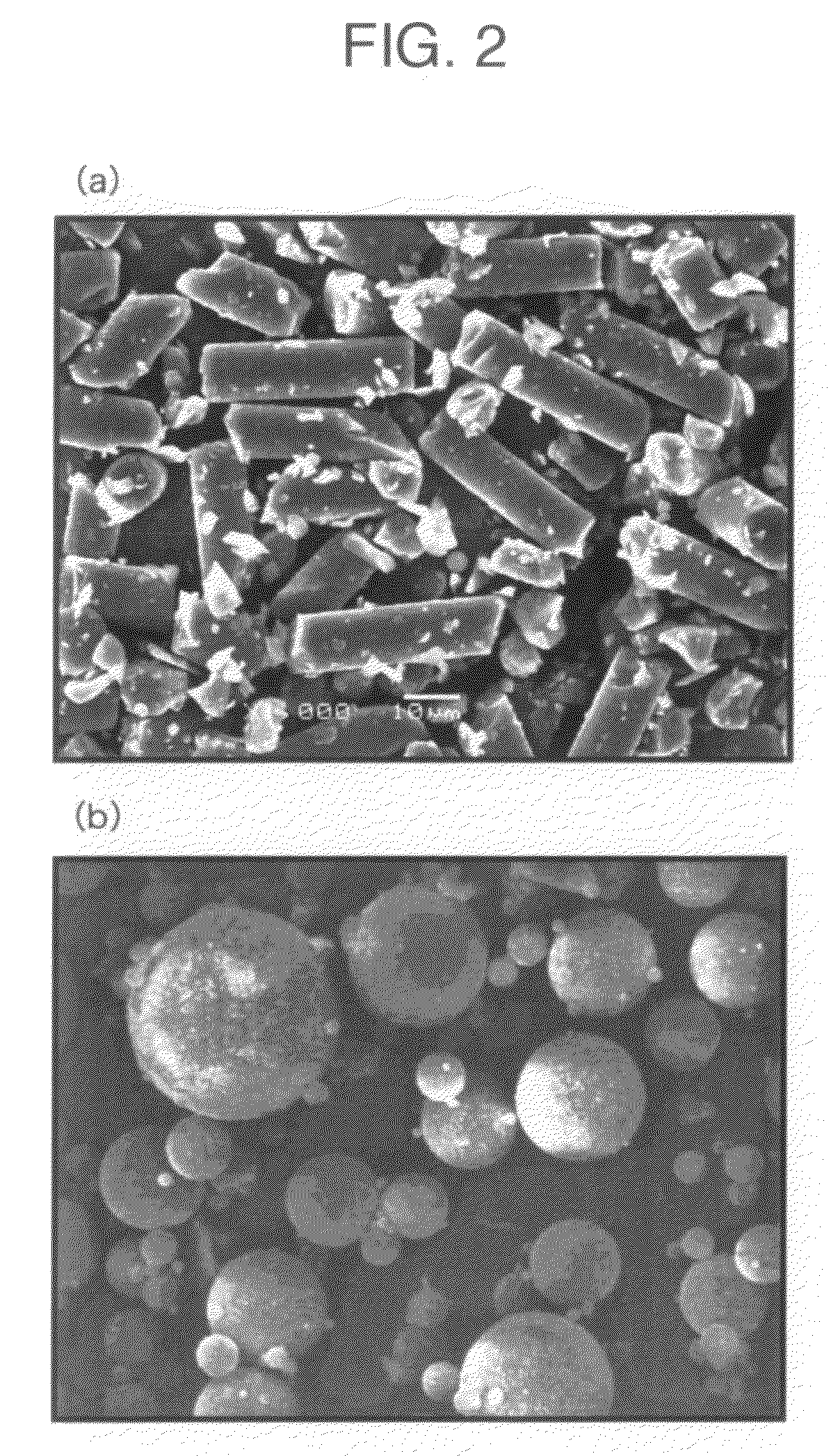Process for producing spherical inorganic particle
a technology of inorganic particles and process, which is applied in the field of process for producing spherical inorganic particles, can solve the problems of deteriorating resin flowability, limited applications as fillers, and insufficient dispersibility of resins, and achieves high flowability, short time, and high proportion
- Summary
- Abstract
- Description
- Claims
- Application Information
AI Technical Summary
Benefits of technology
Problems solved by technology
Method used
Image
Examples
example 1
[0084]Fibrous E-glass having a softening point of 850° C. as a silicate-containing inorganic material, pulverized to have a filament diameter of 11 μm and average fiber length of 21 μm, was carried by air into the system illustrated in FIG. 1 at 15 kg / hour, heated by an air burner, and cooled with sprayed water containing γ-glycidyloxypropyl trimethoxy silane at 0.1% by mass, while the fibers were kept in an atomized state, and collected by a bag filter to produce the spherical E-glass particles.
example 2
[0085]Pulverized crystalline silica (average particle diameter: 15 μm) having a softening point of 1700° C. as a silicate-containing inorganic material was carried by oxygen into the system illustrated in FIG. 1, provided with a cooling zone, at 8 kg / hour, heated by an oxygen burner, and cooled with sprayed water containing γ-glycidyloxypropyl trimethoxy silane at 0.1% by mass, while the particles were kept in an atomized state, and collected by a bag filter to produce the spherical silica particles.
[0086]FIGS. 2 and 3 show scanning electron micrograms of the respective spherical inorganic particles produced in Examples 1 and 2, where (a) shows the pulverized product and (b) the spherical inorganic particles. As shown in FIG. 2 (b), the spherical E-glass particles produced in Example 1 had a highly circular cross-section, having an average particle diameter of about 18 μm and specific surface area of about 0.4 m2 / g. As shown in FIG. 3 (b), the spherical silica particles produced in ...
example 3
[0088]Chopped strands of fibrous E-glass having an observed composition given in Table 1, average length of 25 mm and softening point of 850° C. was used as a silicate-containing vitreous inorganic material.
[0089]They were ball-milled to an average particle diameter of 25 μm, and carried by air into the system illustrated in FIG. 1 at 15 kg / hour and heated by an air burner to produce the spherical particles.
[0090]Then, they were immersed in a 1.0 N aqueous nitric acid solution (500 cc per 20 g of the sample) at 70° C. for 1 hour for the acid treatment, and then washed with water and dehydrated.
[0091]The acid treatment was carried out (1) before the pulverization step, (2) after the pulverization step and before the spheroidization step, and (3) after the spheroidization step.
[0092]For measurement of electroconductivity, 10 g of the sample subjected to all of the pulverization, acid treatment and spheroidization steps was immersed in 100 cc of pure water with stirring and then the im...
PUM
| Property | Measurement | Unit |
|---|---|---|
| diameter | aaaaa | aaaaa |
| diameter | aaaaa | aaaaa |
| particle diameter | aaaaa | aaaaa |
Abstract
Description
Claims
Application Information
 Login to View More
Login to View More - R&D
- Intellectual Property
- Life Sciences
- Materials
- Tech Scout
- Unparalleled Data Quality
- Higher Quality Content
- 60% Fewer Hallucinations
Browse by: Latest US Patents, China's latest patents, Technical Efficacy Thesaurus, Application Domain, Technology Topic, Popular Technical Reports.
© 2025 PatSnap. All rights reserved.Legal|Privacy policy|Modern Slavery Act Transparency Statement|Sitemap|About US| Contact US: help@patsnap.com



